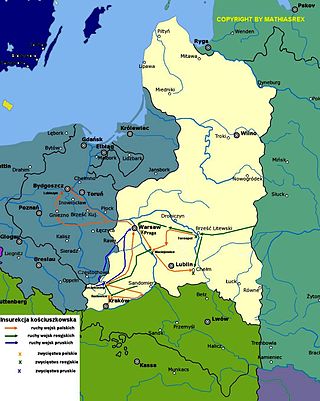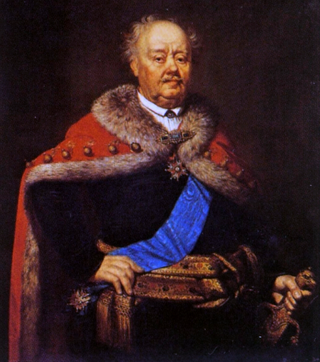
Stanisław II August, known also by his regnal Latin name Stanislaus II Augustus, and as Stanisław August Poniatowski, was King of Poland and Grand Duke of Lithuania from 1764 to 1795, and the last monarch of the Polish–Lithuanian Commonwealth.

Jan Alojzy Matejko was a Polish painter, a leading 19th-century exponent of history painting, known for depicting nodal events from Polish history. His works include large scale oil paintings such as Stańczyk (1862), Rejtan (1866), Union of Lublin (1869), Astronomer Copernicus, or Conversations with God (1873), or Battle of Grunwald (1878). He was the author of numerous portraits, a gallery of Polish monarchs in book form, and murals in St. Mary's Basilica, Kraków. He is considered by many as the most celebrated Polish painter, and sometimes as the "national painter" of Poland.

The Kościuszko Uprising, also known as the Polish Uprising of 1794, Second Polish War, Polish Campaign of 1794, and the Polish Revolution of 1794, was an uprising against the Russian and Prussian influence on the Polish–Lithuanian Commonwealth, led by Tadeusz Kościuszko in Poland-Lithuania and the Prussian partition in 1794. It was a failed attempt to liberate the Polish–Lithuanian Commonwealth from external influence after the Second Partition of Poland (1793) and the creation of the Targowica Confederation.

Tadeusz Reytan was a nobleman from the Polish–Lithuanian Commonwealth. He was a member of the Sejm of the Polish–Lithuanian Commonwealth from the Nowogródek Voivodeship. Reytan is remembered for a dramatic gesture he made in September 1773, as a deputy of the Partition Sejm. There, Reytan tried to prevent the legalization of the first partition of Poland, a scene that has been immortalized in the painting Rejtan by Jan Matejko. He has been the subject of many other art works, and is a symbol of patriotism in Lithuania, Belarus and Poland. Despite his efforts, the partition of Polish–Lithuanian Commonwealth was legalized soon afterwards.

Prince Karol Stanisław Radziwiłł was a Polish nobleman, diplomat and prince of the Commonwealth. He is frequently referred to by his well-known sobriquet Panie Kochanku to distinguish him from his earlier namesake. Prince Radziwiłł held several important posts; from 1752 he was the Master Swordbearer of the Lithuania, and in 1757 he became one of the first recipients of the Order of the White Eagle. From 1762 he was Voivode of Vilnius.

Count Roman Ignacy Potocki, generally known as Ignacy Potocki, was a Polish nobleman, member of the influential magnate Potocki family, owner of Klementowice and Olesin, a politician, statesman, writer, and office holder. He was the Marshal of the Permanent Council in 1778–1782, Grand Clerk of Lithuania from 1773, Court Marshal of Lithuania from 1783, Grand Marshal of Lithuania from 16 April 1791 to 1794.

Franciszek Ksawery Branicki (1730–1819) was a Polish nobleman, magnate, French count, diplomat, politician, military commander, and one of the leaders of the Targowica Confederation. Many consider him to have been a traitor who participated with the Russians in the dismemberment of his nation.

The Great Sejm, also known as the Four-Year Sejm was a Sejm (parliament) of the Polish–Lithuanian Commonwealth that was held in Warsaw between 1788 and 1792. Its principal aim became to restore sovereignty to, and reform, the Commonwealth politically and economically.

The Targowica Confederation was a confederation established by Polish and Lithuanian magnates on 27 April 1792, in Saint Petersburg, with the backing of the Russian Empress Catherine II. The confederation opposed the Constitution of 3 May 1791 and fought in the Polish–Russian War of 1792, which led to the Second and Third Partitions of Poland.

The Patriotic Party, also known as the Patriot Party or, in English, as the Reform Party, was a political movement in the Polish–Lithuanian Commonwealth in the period of the Four-Year Sejm of 1788–1792, whose chief achievement was the Constitution of 3 May 1791. The reformers aimed to strengthen the ailing political machinery of the Commonwealth, to bolster its military, and to reduce foreign political influence, particularly that of the Russian Empire. It has been called the first Polish political party, though it had no formal organizational structure. The Party was inspired by the ideals of the French Revolution, and its name, proudly used by themselves, was a tribute to the Dutch Patriots.
Silent Sejm, also known as the Mute Sejm, is the name given to the session of the Sejm parliament of the Polish–Lithuanian Commonwealth of 1 February 1717 held in Warsaw. A civil war in the Commonwealth was used by the Russian Tsar Peter the Great as an opportunity to intervene as a mediator. It marked the end of Augustus II of Poland's attempts to create an absolute monarchy in Poland, and the beginning of the Russian Empire's increasing influence and control over the Commonwealth.

Ignacy Wyssogota Zakrzewski (1745–1802) was a notable Polish nobleman, politician, art collector, Freemason, and the Mayor of Warsaw during the last years of the Polish–Lithuanian Commonwealth, in 1792 and 1794.
Romanticism in Poland, a literary, artistic and intellectual period in the evolution of Polish culture, began around 1820, coinciding with the publication of Adam Mickiewicz's first poems in 1822. It ended with the suppression of the January 1863 Uprising against the Russian Empire in 1864. The latter event ushered in a new era in Polish culture known as Positivism.

Silesian Museum in Katowice is a museum in the city of Katowice, Poland.

The Partition Sejm was a Sejm lasting from 1773 to 1775 in the Polish–Lithuanian Commonwealth, convened by its three neighbours in order to legalize their First Partition of Poland. During its first days in session, that Sejm was the site of Tadeusz Rejtan's famous gesture of protest against Partition. The Sejm also passed other legislation, notably establishing the Permanent Council and the Commission of National Education. Cardinal Laws were confirmed.

The History of the Polish–Lithuanian Commonwealth (1764–1795) is concerned with the final decades of existence of the Polish–Lithuanian Commonwealth. The period, during which the declining state pursued wide-ranging reforms and was subjected to three partitions by the neighboring powers, coincides with the election and reign of the federation's last king, Stanisław August Poniatowski.

The Constitution of 3 May 1791 is an 1891 Romantic oil painting on canvas by the Polish artist Jan Matejko. It is a large piece, and one of Matejko's best known. It memorializes the Polish Constitution of 3 May 1791, a milestone in the history of the Polish–Lithuanian Commonwealth and a high point of the Polish Enlightenment.

The Prussian Homage is an oil on canvas painting by Polish painter Jan Matejko painted between 1879 and 1882 in Kraków. The painting depicts the "Prussian Homage", a significant political event from the time of the Renaissance in Poland in which Albrecht of Hohenzollern, the Duke of Prussia paid tribute and swore allegiance to King Sigismund I the Old in Kraków's market square on 10 April 1525. Matejko depicted over thirty important figures of the Polish Renaissance period, taking the liberty of including several who were not actually present at the event.

The Sermon of Piotr Skarga or Skarga's Sermon is a large oil painting by Jan Matejko, finished in 1864, now in the National Museum, Warsaw in Poland. It depicts a sermon on political matters by the Jesuit priest Piotr Skarga, a chief figure of the Counter Reformation in Poland, where he rebukes the Polish elite for neglecting the national interest.
















